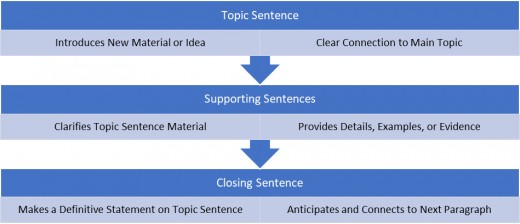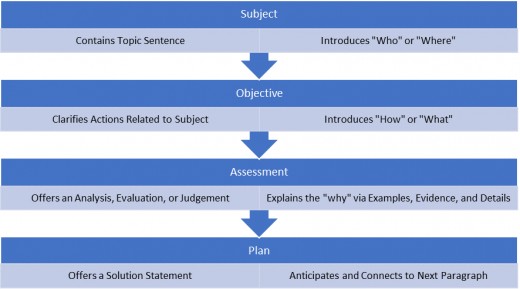Writing and Revising

Overview
The writing process is an undulating experience. In other words, there is not necessarily a straight and narrow path from start to finish. While writing your discovery draft, you may jump between the acts of writing, revising, and reflecting. You may begin to write a sentence, stop mid-way, reread your paragraph, delete a few words, change a phrase, and then pick up where you left off. You might go through dozens of these cycles during a single assignment. In fact, I have already done so several times as I wrote this sentence. After I wrote that last sentence, I reread this whole paragraph to ensure it flowed properly. This is discovery drafting 101 in a nutshell.
Effective Paragraphing
Every composition can be deconstructed into smaller or larger sections. The basic progression from largest to smallest follows like this:

Predictably, the text encompasses the entirety of your composition. Your text will be influenced by a variety of factors such as your intended audience, your authorial intent, your thesis statement, the nature of your topic, and the medium of communication. These will be described in greater detail in future articles.
Paragraphs comprise the ‘meat and potatoes’ of your text. They are visually distinguishable from each other and the purpose of separating your text into paragraphs is to help your readers easily follow the progression of your sub-topics, understand the relationship between sub-topics, and identify how these ideas relate back to your thesis statement or main topic.
Effective paragraphs are exemplified through their organization. The most common formula for paragraph composition is the ‘Sandwich Method.’ This method comprises three parts:

Another effective paragraphing formula is the SOAP Method, or “Subject, Objective, Assessment, and Plan” Method. This formula follows below:

From my experience, the SOAP Method works best for introductory and concluding paragraphs, whereas the Sandwich Method works best for body paragraphs. Be sure to experiment with both in your writing style. Eventually, as you continue practicing your craft, these formulas will become engrained within your unconscious and your writing will flow naturally without thought. Here is an excellent resource that explores writing effective paragraphs in further detail: http://writing2.richmond.edu/writing/wweb/paragrph.html
General Revision and Editing Strategies
As I have previously mentioned, even the best writers revise and proofread their writing. For the most part, this concerns the micro elements of composing such as sentence structure, phrasing, word choice, and punctuation. We will cover these in more depth in future articles because this area of writing focuses on more fine-tuned aspects of composition. Here, I want to continue to focus on the macro elements such as how we can use the FACT Method to enhance paragraph flow.

FACT Revision
The FACT Method stands for: Fit, Add, Cut, and Test. As you reread your writing some of the questions you should be thinking about are:
Is this relevant to my main topic? (Does it Fit?)
Does this idea need supporting examples, evidence, or details? (Can I add something?)
Does my paragraph lack focus and clarity? (Can I cut any wordiness or clutter?)
Is my writing clear, concise, and precise? (Test drive your sentence— does it make sense?)
Acheiving Flow
The main aim of your revision efforts is to establish and ensure your writing has flow. This is arguably the most important aspect of the writing process besides staying on topic. Think about your favorite book, movie, TV show, or song. One of the common denominators linking the success of these various forms of compositions is FLOW. The beginning and end are seamlessly entwined. Every sentence, every word, and every moment are purposeful—there is no wasted energy, no empty breath. Understand, during your writing, every word and idea must build upon each other; every topic sentence should relate to your main topic; every concluding sentence should lead into your next paragraph; every sentence should fit together like pieces to a puzzle. When you revise or review your writing, always be sure to conduct a flow test. Let this guide your revision process.

© 2018 The Professor








